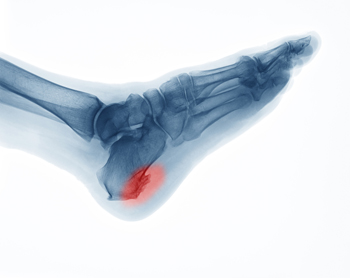
Heel spurs are bony protrusions that form on the bottom of the heel bone. They develop gradually from ongoing strain on the heel area, including repetitive stress activities like running or long periods of standing. The stress on the heel can lead to small tears in the tissues that attach to the heel, prompting the body to build extra bone as a defense mechanism. This becomes a heel spur. While not always painful, heel spurs can cause discomfort, especially when excessive pressure is placed on the heel. People with flat feet or high arches may be more prone to developing heel spurs. A podiatrist can diagnose heel spurs by conducting a physical examination and using imaging techniques like X-rays. Treatment usually involves non-surgical options, such as rest, wearing supportive footwear, or orthotic inserts designed to alleviate pressure on the heel. Surgery is only considered when symptoms persist despite these conservative treatments. If you believe you may have developed a heel spur, it is suggested that you schedule an appointment with a podiatrist for an exam and treatment.
Heel spurs can be incredibly painful and sometimes may make you unable to participate in physical activities. To get medical care for your heel spurs, contact Bruce Smit, DPM from Frankfort Foot & Ankle Clinic. Our doctor will do everything possible to treat your condition.
Heels Spurs
Heel spurs are formed by calcium deposits on the back of the foot where the heel is. This can also be caused by small fragments of bone breaking off one section of the foot, attaching onto the back of the foot. Heel spurs can also be bone growth on the back of the foot and may grow in the direction of the arch of the foot.
Older individuals usually suffer from heel spurs and pain sometimes intensifies with age. One of the main condition's spurs are related to is plantar fasciitis.
Pain
The pain associated with spurs is often because of weight placed on the feet. When someone is walking, their entire weight is concentrated on the feet. Bone spurs then have the tendency to affect other bones and tissues around the foot. As the pain continues, the feet will become tender and sensitive over time.
Treatments
There are many ways to treat heel spurs. If one is suffering from heel spurs in conjunction with pain, there are several methods for healing. Medication, surgery, and herbal care are some options.
If you have any questions feel free to contact our office located in Frankfort, IL . We offer the latest in diagnostic and treatment technology to meet your needs.